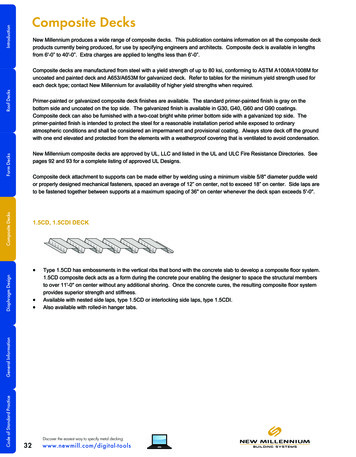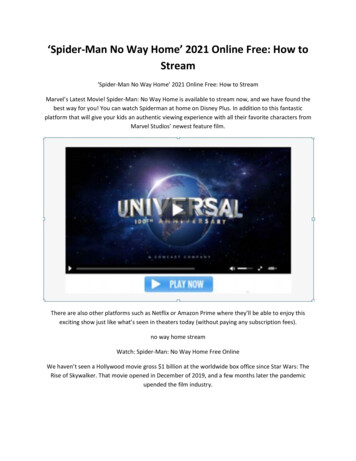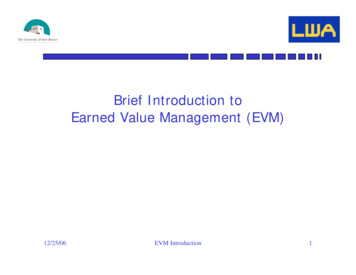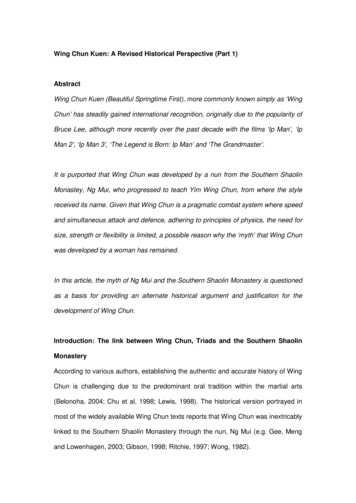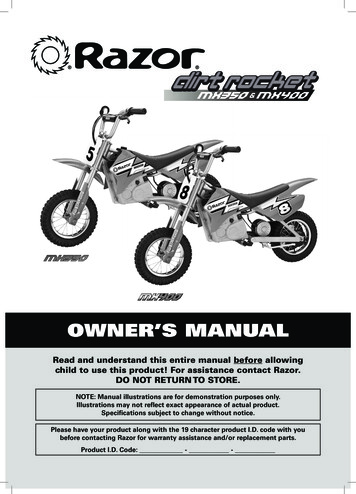
Transcription
OWNER’S MANUALRead and understand this entire manual before allowingchild to use this product! For assistance contact Razor.DO NOT RETURN TO STORE.NOTE: Manual illustrations are for demonstration purposes only.Illustrations may not reflect exact appearance of actual product.Specifications subject to change without notice.Please have your product along with the 19 character product I.D. code with youbefore contacting Razor for warranty assistance and/or replacement parts.Product I.D. Code: - -
CONTENTSSafety Warnings.1-2Before You Begin. 3Assembly and Set-Up.4-5Charging the Battery. 6Pre-ride Checklist. 6Usage. 7Repair and Maintenance.7-10Troubleshooting Guide. 11Product Parts . 12Warranty. 14SAFETY WARNINGSACCEPTABLE RIDING PRACTICES AND CONDITIONSWARNING: Riding an electric motorbike does present potentialrisks and caution is required. Like any riding product, the Dirt Rocket hasinherent hazards associated with its use (for example, falling off or riding itinto a hazardous situation). Like any riding product, the Dirt Rocket can andis intended to move and it is therefore, of course, possible to lose control orotherwise get into dangerous situations. Both children, and adults responsiblefor supervising them, must recognize that if such things occur, a rider canbe seriously injured or die even when using safety equipment and otherprecautions. RIDE AT YOUR OWN RISK AND USE COMMON SENSE.Always check and obey any local laws or regulations, which mayaffect the locations where the electric motorbike may be used. Keepsafely away from cars and motor vehicle traffic at all times, and onlyuse where allowed and with caution.Do not activate the speed control on the hand grip unless you are on theproduct and in a safe, outdoor environment suitable for riding.The normal powered top speed of the Dirt Rocket will be approximately14 mph (22 kmh), which can be affected by conditions, such as rider weight,inclines, tire inflation and battery charge level. Avoid excessive speeds thatcan be associated with downhill rides.WARNING: PARENTAL AND ADULTRESPONSIBILITY AND SUPERVISION IS NECESSARY:Because products, like the Dirt Rocket, can and do present potential hazardsplainly associated with their use, it is well recognized THE NEED FOREXERCISE OF PARENTAL RESPONSIBILITY IN SELECTING RIDING PRODUCTSAPPROPRIATE TO THE AGE OF A CHILD, OR PARENTAL SUPERVISION INSITUATIONS IN WHICH CHILDREN OF VARIOUS AGES MAY HAVE ACCESSTO THE SAME RIDING PRODUCTS, IS IMPORTANT. Not every product isappropriate for every age or size of child, and different age recommendationsare found within this category of product which are intended to reflect thenature of the hazards and the expected mental or physical ability, or both, of achild to cope with the hazards.Maintain a hold on the handlebars at all times. Do not touch the brakes ormotor on your product when in use or immediately after riding as these partscan become very hot.Ride defensively. Watch out for potential obstacles that could catch yourwheel or force you to swerve suddenly or lose control. Be careful to avoidpedestrians, skaters, skateboards, scooters, bikes, children or animals whomay enter your path, and respect the rights and property of others.The Dirt Rocket is intended for use on flat, dry surfaces, such as pavement orlevel ground, without loose debris, such as sand, leaves, rocks or gravel. Wet,slick, bumpy, uneven or rough surfaces may impair traction and contribute topossible accidents. Do not ride your Dirt Rocket in mud, ice, puddles or water.Watch out for potential obstacles that could catch your wheel or force youto swerve suddenly or lose control. Avoid sharp bumps, drainage grates, andsudden surface changes.The recommended minimum rider age is 13 and older. Any rider unableto fit comfortably on the Dirt Rocket should not attempt to ride it. A parent’sdecision to allow his or her child to ride this product should be based on thechild’s maturity, skill and ability to follow rules.Keep this product away from small children and remember that it isintended for use only by persons who are, at a minimum, completelycomfortable and competent while operating the product.Do not attempt or do stunts or tricks on your Dirt Rocket. The Dirt Rocket isnot made to withstand abuse from misuse, such as jumping, curb grindingor any other type of stunts. Racing, stunt riding, or other maneuvers alsoenhance risk of loss of control, or may cause uncontrolled rider actionsor reactions.Persons with any mental or physical conditions that may make themsusceptible to injury, impair their physical dexterity or mental capabilitiesto recognize, understand, and follow safety instructions and to be ableto understand the hazards inherent in product use, should not use or bepermitted to use products inappropriate for their abilities. Persons withheart conditions, head, back or neck ailments (or prior surgeries to theseareas of the body), or pregnant women, should be cautioned not to operatesuch products.Never allow more than one person at a time to ride the Dirt Rocket.Do not ride at night or when visibility is limited.Never use near steps or swimming pools.DO NOT EXCEED THE WEIGHT LIMIT OF 140 lb (64 kg). Rider weightdoes not necessarily mean a person’s size is appropriate to fit ormaintain control of the product.Do not allow hands, feet, hair, body parts, clothing, or similar articles tocome in contact with moving parts, wheels, drivetrain, or chain while themotor is running.CHECK AND MAINTAIN PRODUCT CONDITIONSBefore use, check to confirm that any and all chain guards or othercovers and guards are in place and in serviceable condition. Check thatthe brake is functioning properly, and that tires are inflated properly andhave sufficient tread remaining. The product should be maintained andrepaired in accordance with the manufacturer’s specifications, usingonly the manufacturer’s authorized replacement parts, and should notbe modified from the manufacturer’s original design and configuration.Never use headphones, a cell phone or text when riding.Never hitch a ride with a vehicle.Do not ride your Dirt Rocket in wet or icy weather and never immerse theproduct in water, as the electrical and drive components could be damagedby water or create other possibly unsafe conditions. Never risk damagingsurfaces, such as carpet or flooring, by use of an electric motorbike indoors.1
SAFETY WARNINGSPROPER RIDING ATTIREAlways wear proper protective equipment, such as an approved safety helmet(with chin strap securely buckled), elbow pads and kneepads. A helmet maybe legally required by local law or regulation in your area. A long-sleevedshirt, long pants, and gloves are recommended. Always wear athletic shoes(lace-up shoes with rubber soles) and keep shoelaces tied and out of the wayof the wheels, motor and drive system. Never ride barefooted or in sandals.Use only with the recommended charger.USING THE CHARGERThe charger supplied with the electric motorbike should be regularly examinedfor damage to the cord, plug, enclosure and other parts. In the event of suchdamage, the product must not be charged until the charger has been repairedor replaced.Always disconnect from the charger prior to wiping down and cleaning yourelectric motorbike with damp cloth.Use caution when charging.The charger is not a toy. Charger should be operated by an adult.Do not operate charger near flammable materials.Unplug charger and disconnect from product when not in use.FAILURE TO USE COMMON SENSE AND HEED THE ABOVEWARNINGS FURTHER INCREASES RISK OF SERIOUS INJURY. USEAT YOUR OWN RISK AND WITH APPROPRIATE AND SERIOUSATTENTION TO SAFE OPERATION. USE CAUTION.2
BEFORE YOU BEGINRemove contents from box. Remove the separators that protect the components from damage during shipping. Inspect thecontents of the box for scratches in the paint, dents or kinked cables that may have occurred during shipping. Because theDirt Rocket is 95 percent assembled and packed at the factory, there should not be any problems, even if the box has afew scars or dents.MAKE SURE POWER SWITCH IS TURNED “OFF” BEFORE CONDUCTING ANY MAINTENANCE PROCEDURES.Estimated Assembly and Set-Up TimeRazor recommends assembly by an adult.Allow up to 15 minutes for assembly.Allow up to 12 hours for initial charge (see page 6 for charging information).Charger(Note: Charger design may varyfrom one shown)Brake LeverWARNING:DO NOT USE NON-RAZORPRODUCTS WITH YOUR RAZORDIRT ROCKET. The Dirt Rockethas been built to certain Razordesign specifications. Theoriginal equipment supplied atthe time of sale was selectedon the basis of its compatibilitywith the frame, fork and allother parts. Certain aftermarketproducts may not be compatibleand will void your warranty.Front ForkPRODUCT I.D. CODEThrottle1.2.3.4.Underneath FrameChargerBattery CoverUPC Side of Box (not shown)Chain GuardRequired ToolsPlastic Bag Contents: 5 mm and 6 mmAllen Wrenches10 mm WrenchChargerToolsHandlebar ClampsOwner’s ManualSpoke TightenerNeed Help? Visit our web site for replacement parts, product support, a list of authorized service centers in the US and customer service contact informationat www.razor.com. Please have the product I.D. code (located on the white label of your product) available for better assistance. Additional Customer Servicecontact information is listed at the back of this manual.3
ASSEMBLY AND SET-UPAttaching the HandlebarsWARNING:Failing to properly adjust andtighten the bolts that affix thehandlebars can cause you to losecontrol and crash.Tool Required: 6 mm Allen Wrench1 Place the handlebars in thehandlebar clamps.2 Align parallel to the fork andtighten the bolts using a 6 mm Allenwrench. When properly tightened,the handlebars should not moveforward or backward.Attaching the Front FenderTools Required: 10 mm Wrench and 5 mm Allen WrenchAlign fender with the hole in thefork and insert the bolt. Tightensecurely using a 10 mm wrenchand 5 mm Allen wrench.Attaching the Number PlateNo tools requiredSlip the cables through the slit on thetop of the number plate. Align thenumber plate with the holes on thefork and snap on the number plate.4
ASSEMBLY AND SET-UPChecking Spoke ke19204321Nipple2 Start with spoke closest to the1 Verify the spoke tension by grasping and shaking each spoke. Spokeshould not be loose from hub. Look for any play between the spoke flangeswhere it mates with the hub. Try to turn the nipple using your fingers. Youshould not be able to spin any nipple by hand. If one or more spokes is loose,all spokes should be checked and tightened with a spoke tightener.tire valve stem and tighten eachnipple, in sequence, exactly 1/4to 1/2 turn. A single 1/4 to 1/2turn may not be enough to bringthe spokes into proper tension.Continue tightening all spokes nomore than 1/2 turn in sequenceuntil all spokes are tight.Note: More than a 1/2 turn eachcan cause the wheel to becomedistorted and wobbly, thuspermanently damaging the wheel.Inflating the TiresTires are inflated when shipped, but they invariably lose some pressure between the point of manufacturing andyour purchase. Inflate the tires to the correct PSI before first time use.Lower air pressure can result in a shorter ride time.Periodically check both tires. Reinflate when needed.WARNING:Do not use the Dirt Rocket for thefirst time until you have inflated thetires to the correct PSI. Failure to doso may damage your motor bike andvoid your warranty.WARNING:Do not over inflate, as this coulddamage the tire or wheel.Using a bicycle tire pump equipped fora Schrader valve, inflate both tires tothe PSI indicated on the sidewall ofthe tire.Note: The pressurized air suppliesfound at gasoline stations aredesigned to inflate high-volumeautomobile tires. If you decide touse such an air supply to inflateyour tires, first make sure thepressure gauge is working, thenuse very short bursts to inflate tothe correct PSI. If you inadvertentlyover-inflate the tire, release theexcess pressure immediately.Need Help? Visit our web site for replacement parts, product support, a list of authorized service centers in the US and customer service contact informationat www.razor.com. Please have the product I.D. code (located on the white label of your product) available for better assistance. Additional Customer Servicecontact information is listed at the back of this manual.5
CHARGING THE BATTERYYour Dirt Rocket may not have a fully charged battery; therefore you must charge the battery prior to use. Initial charge time: 12 hours. Make sure the Dirt Rocket’s power switch is turned OFFwhen unit is not in use. If the power switch is left on Recharge time: up to 12 hours, even if the light turns green.for an extended period of time, the battery may reach aRecommended maximum charging time is 24 hours.stage at which it will no longer hold a charge. Always charge the battery immediately after riding. To ensure long battery life, never store the product in Fully charge battery before storing for extendedfreezing or below freezing temperatures! Freezing willperiods of time.permanently damage the battery. Unplug charger from the wall outlet when not in use. Run time: Up to 30 minutes of continuous ride time. Failure to recharge battery periodically may result in aRun time may vary depending on riding conditions, riderbattery that will not accept a charge.weight, climate, and/or proper maintenance. Constant stopping and starting may shorten ride time. Battery life can vary depending on proper maintenanceand usage of the unit.WARNING:Use ONLY with the recommendedcharger. Batteries are only to becharged under adult supervision.The charger is not a toy. Alwaysdisconnect the charger beforewiping down and/or cleaning theDirt Rocket with a damp cloth.The charger supplied with theDirt Rocket should be regularlyexamined for damage to the cord,plug, enclosure and other parts. Inthe event of such damage, the DirtRocket must not be charged until ithas been repaired or replaced.Chargers have built-in overchargeprotection to prevent battery frombeing overcharged.Note: If the charger gets warmduring regular use, this is a normalresponse and is no cause forconcern. If your charger does not getwarm during use, it does not meanthat it is not working properly.Wall outlet - Green (stand by)Wall outlet and Unit - Red (Charging)Charging complete - Green (Charged)ChargerLEDNote: Make sure power is turnedOFF when unit is not in use. Ifthe power switch is left on for anextended period of time, the batterymay reach a stage at which it willno longer hold a charge.2 Make sure the power switch1 Plug the charger plug into wallis in the OFF position. Plug thecharger into the charger porton the product. The light on thecharger should turn red duringcharging. The light will turn greenwhen the charging is complete.outlet. The light on the chargershould be green.Note: If green light (LED) does notturn on, try a different outletNote: Continue charging unit even iflight turns green prior to 12 hours.WARNING: Battery chargecan deplete over time. Periodicallyrecharge battery when not in use.PRE-RIDE CHECKLISTBrakeHardware/Loose PartsCheck the brake for proper function. When you squeeze thelever, the brake should provide positive braking action. Whenyou apply the brake with the speed control on, the brake cut-offswitch will stop the motor.Before every ride, check all parts, such as nuts, bolts, cables,fasteners, etc., to ensure they are secure and assembled correctly.There should not be any unusual rattles or sounds from looseparts or broken components. If the unit is damaged, do not ride.Reference “Safety Warnings” on pages 1 and 2 of thismanual.TiresPeriodically inspect the tires for excess wear and replace asneeded. Regularly check the tire pressure and inflate as needed.If you get a flat tire, the inner tube can be patched or a new tubecan be purchased from Razor or an authorized repair center.Safety GearAlways wear proper protective gear, such as an approved safetyhelmet. Elbow pads, kneepads, pants and long sleeves arerecommended. Always wear closed toe shoes (lace-up with rubbersoles) and keep shoelaces tied and out of the way of the wheels,motor and drive system. NEVER RIDE BAREFOOTED ORIN SANDALS.Frame, Fork and HandlebarsCheck for cracks or broken connections. Although broken framesare rare, it is possible for an aggressive rider to run into a curbor object and wreck, bend or break the frame. Get in the habit ofinspecting your product on a regular basis.Laws and RegulationsAlways check and obey any local laws or regulations.InsuranceDo not assume that your existing insurance policies necessarilyprovide coverage for electric product use. Check with yourinsurance company for information regarding insurance.6
USAGEStarting the Dirt RocketStopping the Dirt RocketPlace both hands on the handlebars. Slowly push forward with one foot andapply the throttle.Note: Keep both feet on the foot pegs when unit is in motion.Release the throttle and apply the brake.Note: When coming to a complete stop, place both feet on the ground tobalance the unit.REPAIR AND MAINTENANCETurn power switch “OFF” before beginning repair or maintenance: Read the instructions Remove charger plug Turn the power switch off Secure the unit under repair Exercise caution aroundexposed parts Contact Razor customer serviceif unsure about any repair ormaintenanceTesting the BrakeTo use the brake, squeeze the lever to increase the pressure on the brake. The brake lever is fitted with a cableadjuster to compensate for cable stretch and/or to fine-tune the lever movement to engage the brake. If brake isnot engaging properly, follow instructions for adjusting the brake outlined below.Adjusting the BrakeTool Required: 10 mm Wrench1 To adjust the tension, threadthe brake lever adjuster in or out1/4 to 1/2 turn until the desiredbrake adjustment is attained. Mostadjustments are complete at thisstep. If brake still needs furtheradjustment, proceed to step 2.WARNING:The brake is capable of causing theelectric motorbike to skid the tire,throwing an unsuspecting rider.Practice in an open area free fromobstacles until you are familiar withthe brake function. Avoid skidding toa stop as this can cause you to losecontrol or damage the rear tire.Note: The brake lever contains asafety switch to cut power to themotor when the brake is applied. Inan emergency, applying the brakewill always stop the product frommoving. Do not disable or replacethis lever with anything other than agenuine Razor replacement part.2 If the brake has too much slack,use a 10 mm wrench to loosen thebrake anchor cable for additionaladjustment and retighten.Need Help? Visit our web site for replacement parts, product support, a list of authorized service centers in the US and customer service contact informationat www.razor.com. Please have the product I.D. code (located on the white label of your product) available for better assistance. Additional Customer Servicecontact information is listed at the back of this manual.7
REPAIR AND MAINTENANCEChain and Rear Wheel ReplacementTools Required: Phillips Screwdriver, 10 mm Wrench, two (2) 8 mm Wrenches, and two (2) 15 mm Wrenches.1 Using a Phillips screwdriverremove the screws on chain guardand remove.ChainTensioner2 With a 10 mm wrench, loosen3 With two (2) 8 mm wrenchesthe brake cable anchor bolt anddisconnect the cable.remove the cable guide bracket fromthe frame and brake plate. Keep thespacer and washers together.ChainTensionerNote the hardware sequence(from outside toward the center).17-217-317-417-117-217-24 With two (2) 15 mm wrenches,loosen the axle. Push the chaintensioner down to loosen the chainand remove wheel.Nut5 Install the chain onto the rear6 Verify chain is properly installedwheel sprocket. Slip wheel axle intothe frame slots. Push the chain tensioner down to create slack in chain.Hand tighten rear axle locknuts.on each sprocket and tensioner iscorrectly positioned at the bottom ofthe chain.Left Side (Brake)17-1 15 mm Flange Locknut17-2 Flat Washer17-2 Flat WasherFrame17-3 Washer17-4 Brake PlateCable GuideBracketFrameSpacer17-317-217-1BoltWasherBrake Plate7 Install the cable guidebracket to the frame and brakeplate using bolt, washers, andnut. Do not tighten.8 Thread the brake cable through9 Tighten the cable guide bracketthe brake adjuster barrel, throughthe large spring, and into the smallhole in the side of the anchor bolt.Position the cable to the originallocation (as indicated by the slightcable kink) and tighten securely.bolt. Tighten the locknuts on therear axle. Test the brake to verifyproper function before riding.Readjust as needed.8Right Side (Throttle)17-1 15 mm Flange Locknut17-2 Flat Washer17-2 Flat WasherFrame17-3 Washer
REPAIR AND MAINTENANCEFront Wheel ReplacementTools Required: Phillips Screwdriver and 15 mm Wrench1 Using a Phillip screwdriver,loosen the two (2) screws onthe fork covers (2 per side) andremove covers.2 Remove the nuts on both sides3 Remove front wheel andof the front axle using a 15 mmwrench then remove the axlesafety washers.install replacement wheel.Re-attach fork covers.Replacing the FuseWARNING:To prevent shock, please follow theinstructions accordingly and do notskip or combine any steps.Tools Required: 5 mm Allen Wrench, Phillips Screwdriver, and 8 mm Wrench1 Twist the black plastic capand remove.2 Using a 5 mm Allen wrench,3 Using a 5 mm Allen wrench,remove the bolt.loosen the two (2) boltsunderneath the rear of the seatand remove the fairing.30 Amp4 On the opposite side of thecharger port, locate and remove thefive (5) Phillips screws and lock nutson the battery cover using a Phillipsscrewdriver and 8 mm wrench.Separate and remove cover.5 Locate the fuse box attached6 Remove the fuse and replaceto the batteries. Open the fusecover to expose the fuse.with a new one of equalamperage. Close the fuse coverand reattach the battery cover,fairing, and plastic cap.Need Help? Visit our web site for replacement parts, product support, a list of authorized service centers in the US and customer service contact informationat www.razor.com. Please have the product I.D. code (located on the white label of your product) available for better assistance. Additional Customer Servicecontact information is listed at the back of this manual.9
REPAIR AND MAINTENANCEBattery Care and DisposalDo not store in freezing or below freezing temperatures. To properly maintain your battery and ensure maximum batterylife, carefully read the “Charging the Battery” section on page 6 of this owner’s manual.PbCONTAINS SEALED NON-SPILLABLE LEAD BATTERIES. BATTERIES MUST BE RECYCLED.PbDisposal: Your Razor product uses sealed lead-acid batteries which must be recycled or disposed of in anenvironmentally sound manner. Do not dispose of a lead-acid battery in a fire. The battery may explode or leak. Do notdispose of a lead-acid battery in your regular household trash. The incineration, land filling or mixing of sealed leadacid batteries with household trash is prohibited by law in most areas. Return exhausted batteries to a federal or stateapproved lead-acid battery recycler or a local seller of automotive batteries. If you live in Florida or Minnesota, it isprohibited by law to throw away lead-acid batteries in the municipal waste stream.WARNING:If a battery leak develops, avoidcontact with the leaking acid andplace the damaged battery in aplastic bag. Refer to the disposalinstructions at left. If acid comesinto contact with skin or eyes, flushwith cool water for at least 15minutes and contact a physician.WARNING: Battery posts,terminals and related accessoriescontain lead and lead compounds.Wash your hands after handling.ChargerThe charger supplied with the product should be regularly examined for damage to the cord, plug, enclosure and otherparts, and in the event of such damage, the electric motorbike must not be charged until it has been repaired or replaced.Use ONLY with the recommended charger.WheelsWheels and drive system are subject to normal wear and tear. It is the responsibility of the user to periodically inspectwheels for excess wear and adjust and replace drive train components as required.Replacement PartsThe most frequently requested replacement parts are available for purchase at some Razor retail partners.For the complete selection of replacement parts visit shop.razor.com.Service CentersFor a list of authorized Razor repair centers: Check online at www.razor.com. Additional Customer Service contact information is listed on the back of this manual.Need Help? Visit our web site for replacement parts, product support, a list of authorized service centers in the US and customer service contact informationat www.razor.com. Please have the product I.D. code (located on the white label of your product) available for better assistance. Additional Customer Servicecontact information is listed at the back of this manual.10
TROUBLESHOOTING*Unit(s) should be turned off and fully charged prior to doing any TroubleshootingNOTE: All troubleshooting steps should be performed by an adult onlyProblemPossible CauseSolutionElectric motorbike does not runUndercharged batteryCharge the battery. A new battery should have been charged for at least 12 hoursbefore using the electric motorbike for the first time and up to 12 hours after eachsubsequent use.Check all connectors. Make sure the charger connector is tightly plugged into thecharging port, and that the charger is plugged into the wall.Make sure power flow to the wall outlet is on.Loose wires or connectorsCheck all wires and connectors to make sure they are tight.The fuse will burn out and automatically shut off the power if the motor is overloaded.Electric motorbike was runningbut suddenly stoppedBurned-out fuseAn excessive overload, such as too heavy a rider or too steep a hill, could cause themotor to overheat. Replace the fuse with a new one of equal amperage. Correct theconditions that caused the fuse to burn out and avoid repeatedly burning out fuse(Refer to page 9 of this manual).Contact your local Razor authorized service center for diagnosis and repair.Short run time (less than15 minutes per charge)Motor or electrical switch damageCharge the battery. A new battery should have been charged for at least 12 hoursbefore using the electric motorbike for the first time and up to 12 hours after eachsubsequent use.Undercharged batteryCheck all wires and connectors. Make sure the battery connector is tightly pluggedinto the charger connector, and that the charger is plugged into the wall.Tires are not properly inflatedThe tires are inflated when shipped but they invariably will lose some pressurebetween the point of manufacturing and your purchase. Refer to instructions onpage 5 of this manual to properly inflate tires.Battery is old and will not acceptfull chargeEven with proper care, a rechargeable battery does not last forever. Average batterylife is 1 to 2 years depending on product use and conditions. Replace only with aRazor replacement battery.Brakes are not adjusted properlyRefer to brake adjustment instructions on page 7 of this manual.Riding conditions are too stressfulUse only on solid, flat, clean and dry surfaces, such as pavement or level ground.Tires are not properly inflatedThe tires are inflated when shipped, but they invariably will lose some pressurebetween the point of manufacturing and your purchase. Refer to instructions onpage 5 of this manual to properly inflate tires.Electric motorbike is overloadedMake sure you do not overload the electric motorbike by allowing more than onerider at one time, exceeding the maximum weight limit, going up too steep a hill ortowing objects behind the product.Sometimes the product doesn’trun, but other times it does.Loose wires or connectorsCheck all wires around the motor and all connectors to make sure they are tight.Motor or electrical switch damageContact your local Razor authorized service center for diagnosis and repair.Electric motorbike does not stopwhen applying the brakeBrakes are not adjusted properlyRefer to instructions on page 7 of this manual to properly adjust brakes.Electric motorbike makes loudnoises or grinding soundsChain is too dry.Apply a lubricant such as 3 in 1 or Tri-Flow to the chain.Electric motorbike runssluggishlyFor more troubleshooting tips, a list of available replacement parts or to locate an authorized Service Center in your area,visit our website at www.razor.com or call toll free 1 866 467 2967 to speak to a live Customer Service Representative11
MX350/MX400 PARTSKeep your MX350/MX400 running for years with genuine Razor parts. Visit our web site or e-mail us for more information on spare part availability.(Specifications subject to change without notice.)1. Handlebar Grips (Right/Left)2. Single Speed Twist Grip Throttle2-1. Sleeve3. Handlebar4. Brake Lever Assembly5. Handlebar Clamp (Upper/Lower)6. Front Wheel Complete17.8.9.10.11.12.13.4Front ForkFront Fend
NOTE: Manual illustrations are for demonstration purposes only. Illustrations may not re ect exact appearance of actual product. Speci cations subject to change without notice. Please have your product along with the 19 character product I.D. code with you before contactin
